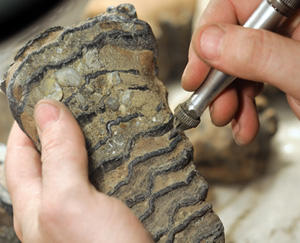Research Shows Radiometric Dating Still Reliable (Again)

Radioactive elements transmute into more stable materials by shooting off particles at a steady rate. For instance, half the mass of carbon-14, an unstable isotope of carbon, will decay into nitrogen-14 over a period of 5,730 years. Archaeologists routinely use radiometric dating to determine the age of materials such as ancient campfires and mammoth teeth.
Recent puzzling observations of tiny variations in nuclear decay rates have led some to question the science of using decay rates to determine the relative ages of rocks and organic materials. Scientists from the National Institute of Standards and Technology (NIST), working with researchers from Purdue University, the University of Tennessee, Oak Ridge National Laboratory and Wabash College, tested the hypothesis that solar radiation might affect the rate at which radioactive elements decay and found no detectable effect.
Atoms of radioactive isotopes are unstable and decay over time by shooting off particles at a fixed rate, transmuting the material into a more stable substance. For instance, half the mass of carbon-14, an unstable isotope of carbon, will decay into nitrogen-14 over a period of 5,730 years. The unswerving regularity of this decay allows scientists to determine the age of extremely old organic materials—such as remains of Paleolithic campfires—with a fair degree of precision. The decay of uranium-238, which has a half-life of nearly 4.5 billion years, enabled geologists to determine the age of the Earth.
Many scientists, including Marie and Pierre Curie, Ernest Rutherford and George de Hevesy, have attempted to influence the rate of radioactive decay by radically changing the pressure, temperature, magnetic field, acceleration, or radiation environment of the source. No experiment to date has detected any change in rates of decay.
Recently, however, researchers at Purdue University observed a small (a fraction of a percent), transitory deviation in radioactive decay at the time of a huge solar flare. Data from laboratories in New York and Germany also have shown similarly tiny deviations over the course of a year. This has led some to suggest that Earth's distance from the sun, which varies during the year and affects the planet's exposure to solar neutrinos, might be related to these anomalies.
Researchers from NIST and Purdue tested this by comparing radioactive gold-198 in two shapes, spheres and thin foils, with the same mass and activity. Gold-198 releases neutrinos as it decays. The team reasoned that if neutrinos are affecting the decay rate, the atoms in the spheres should decay more slowly than the atoms in the foil because the neutrinos emitted by the atoms in the spheres would have a greater chance of interacting with their neighboring atoms. The maximum neutrino flux in the sample in their experiments was several times greater than the flux of neutrinos from the sun. The researchers followed the gamma-ray emission rate of each source for several weeks and found no difference between the decay rate of the spheres and the corresponding foils.
According to NIST scientist emeritus Richard Lindstrom, the variations observed in other experiments may have been due to environmental conditions interfering with the instruments themselves.
"There are always more unknowns in your measurements than you can think of," Lindstrom says.
* R.M. Lindstrom, E. Fischbach, J.B. Buncher, G.L. Greene, J.H. Jenkins, D.E. Krause, J.J. Mattes and A. Yue. Study of the dependence of 198Au half-life on source geometry. Nuclear Instruments and Methods in Physics Research Section A: Accelerators, Spectrometers, Detectors and Associated Equipment. doi:10.1016/j.nima.2010.06.270

